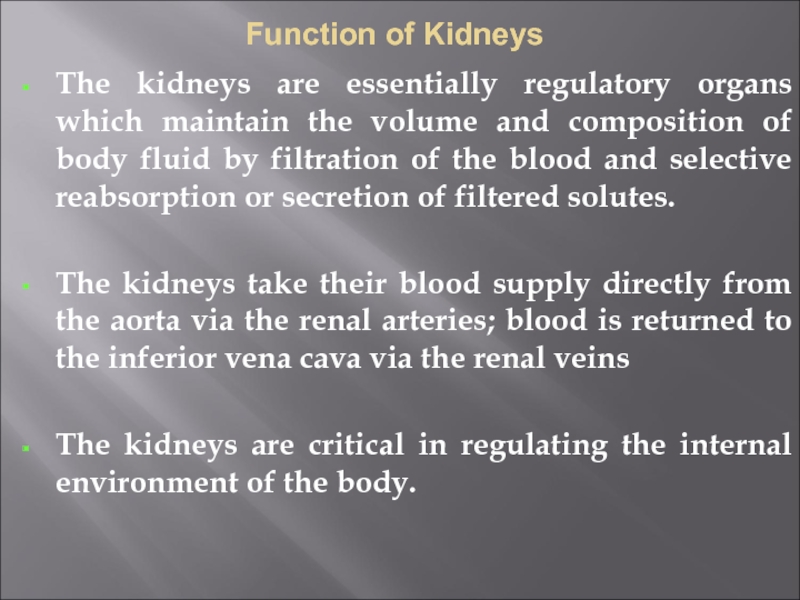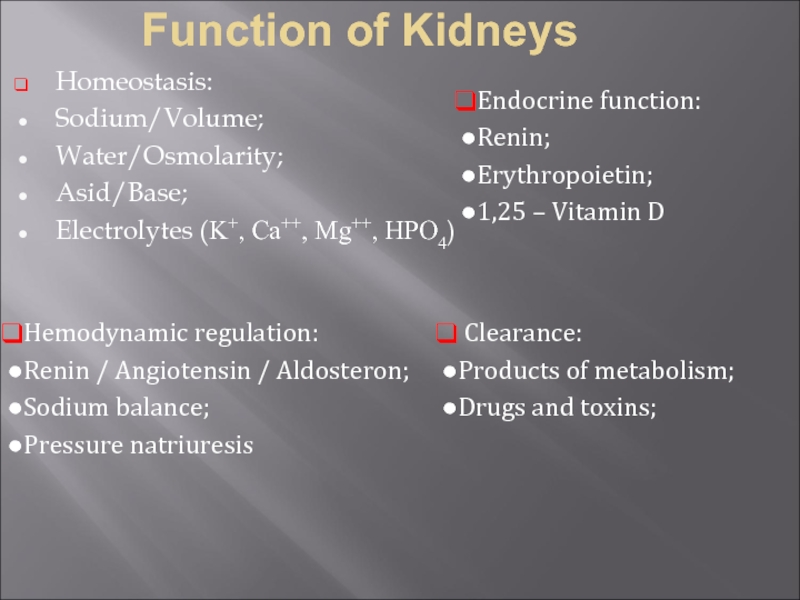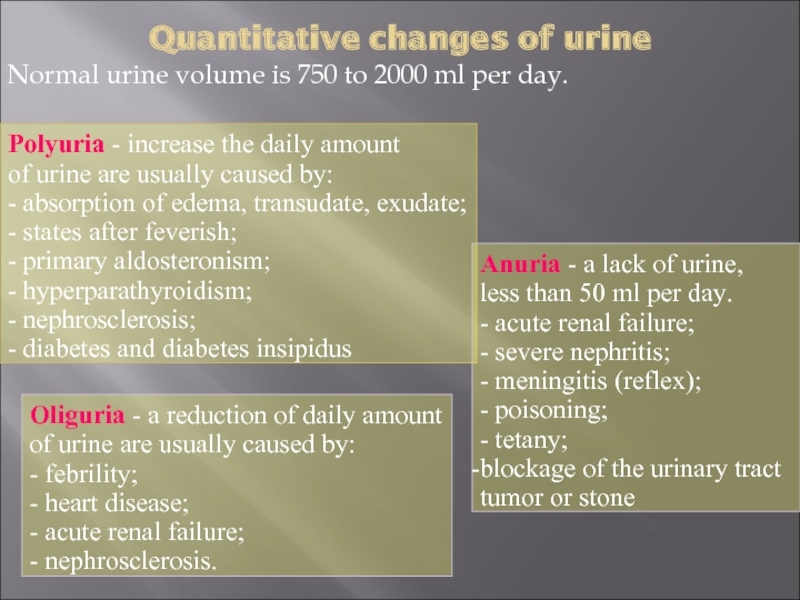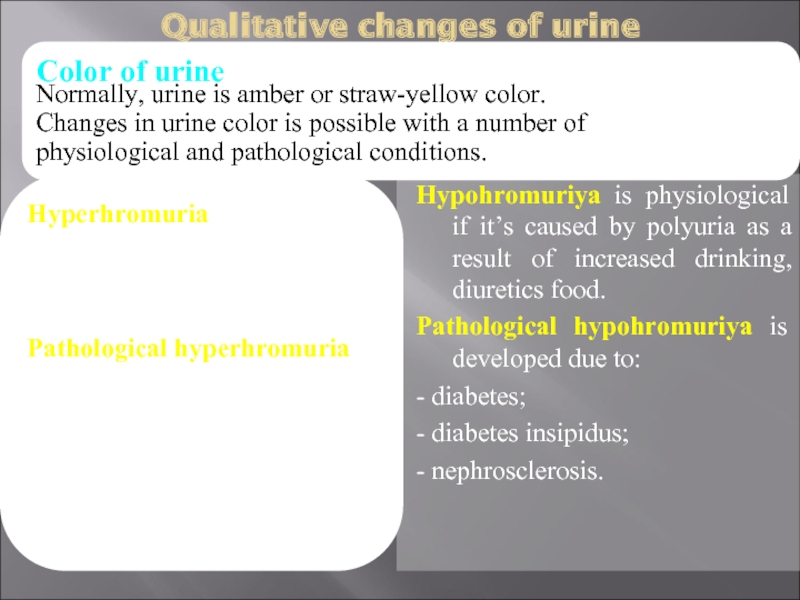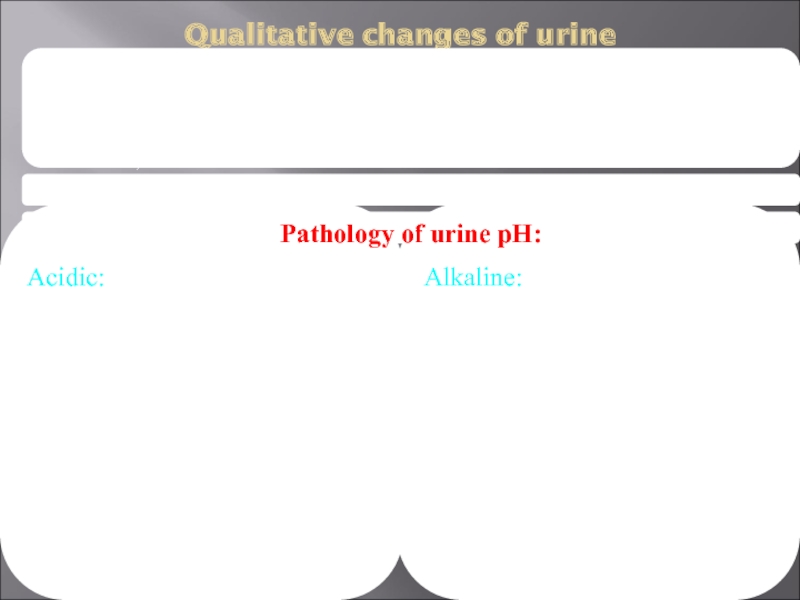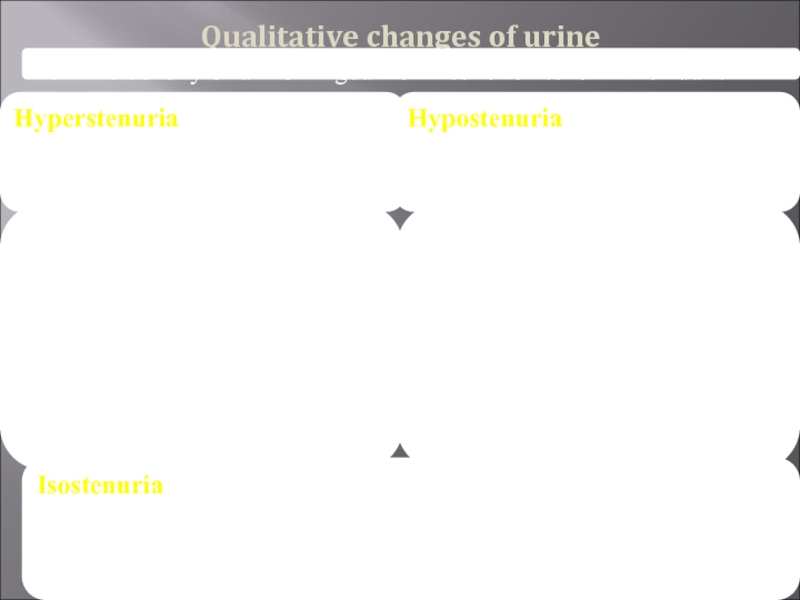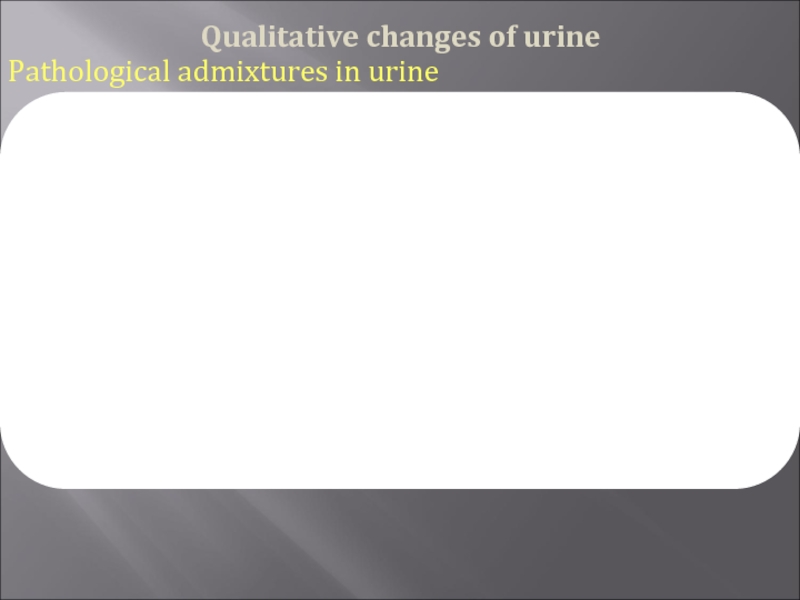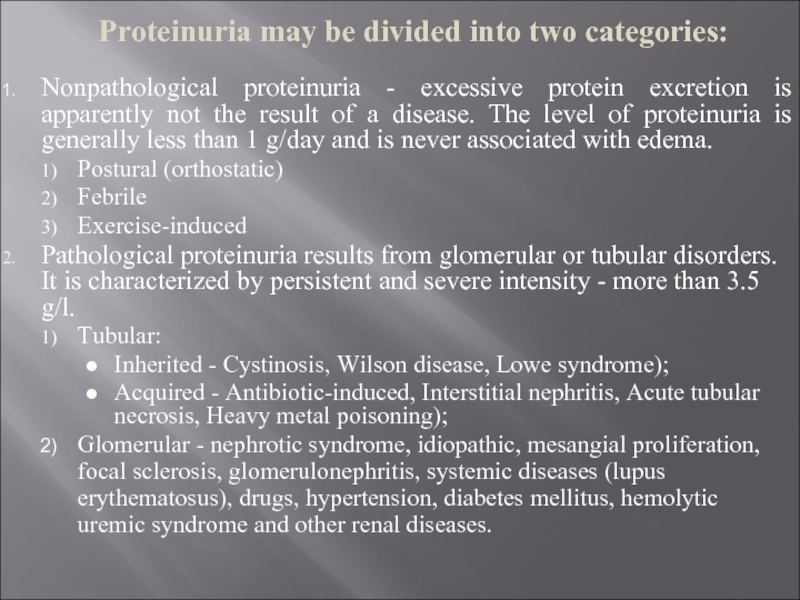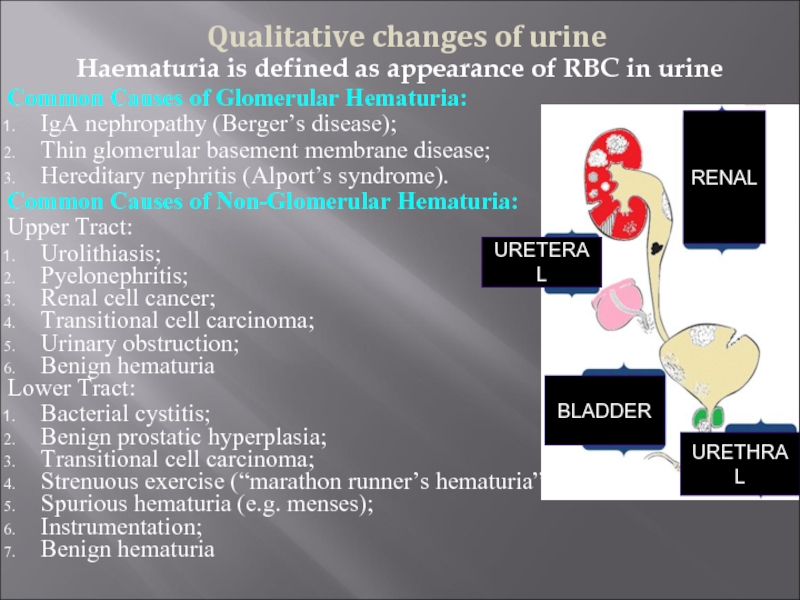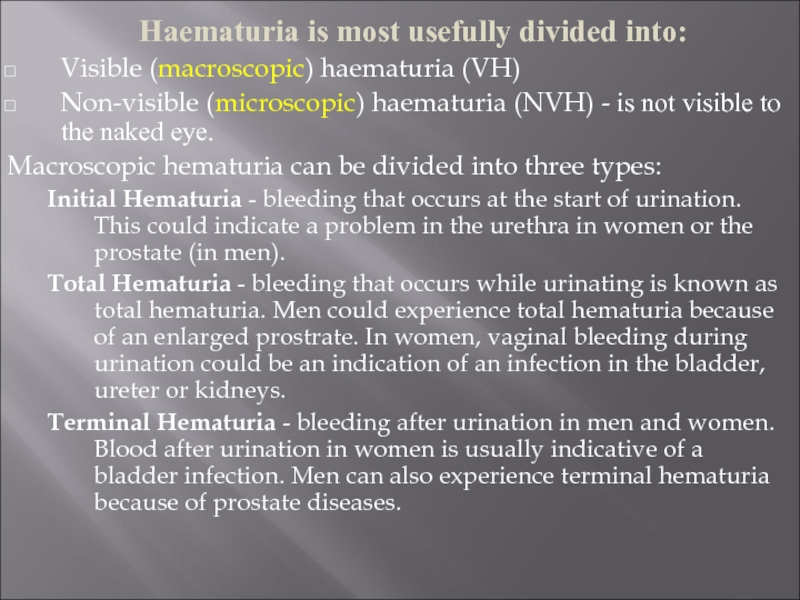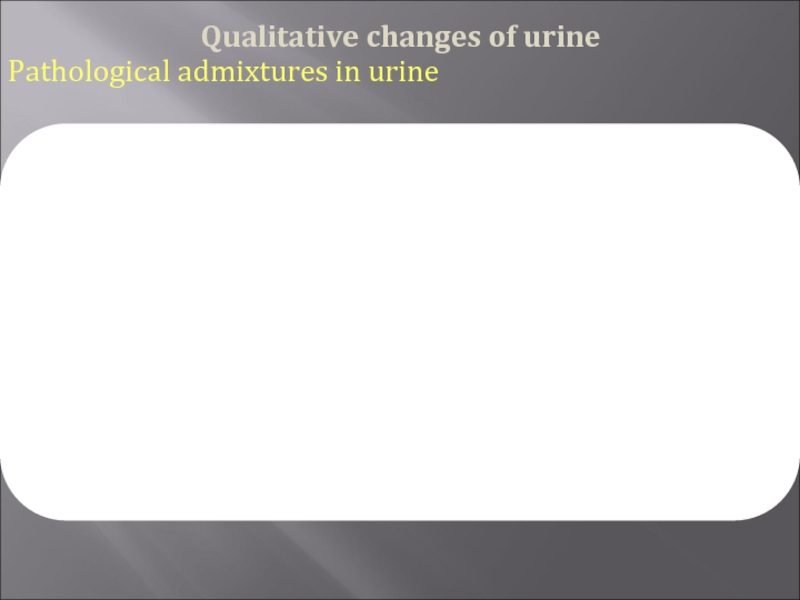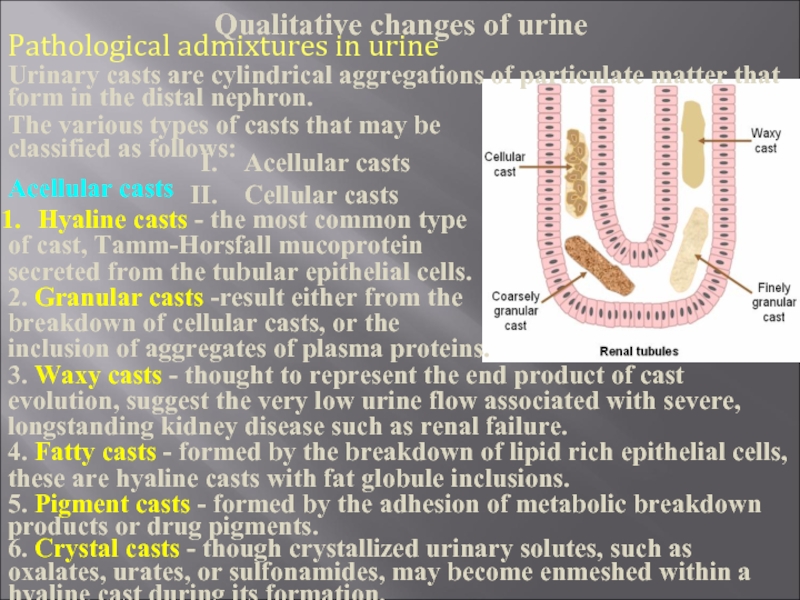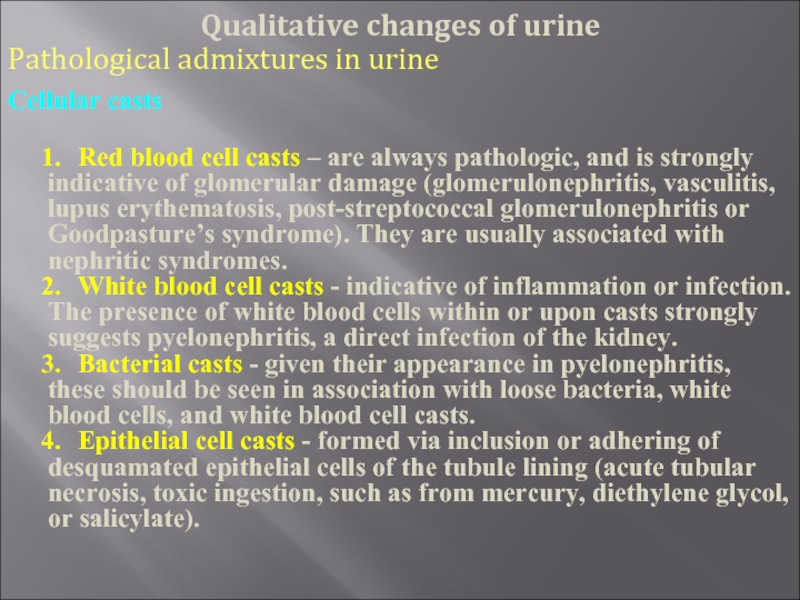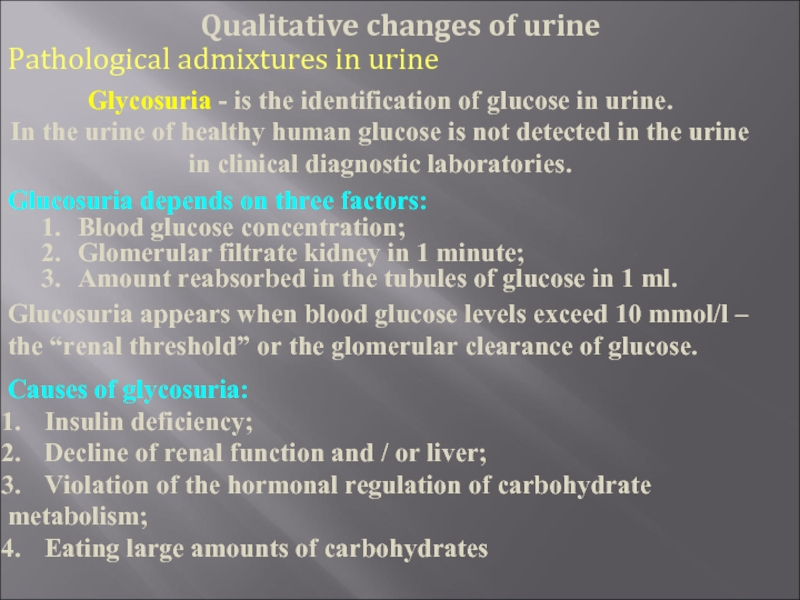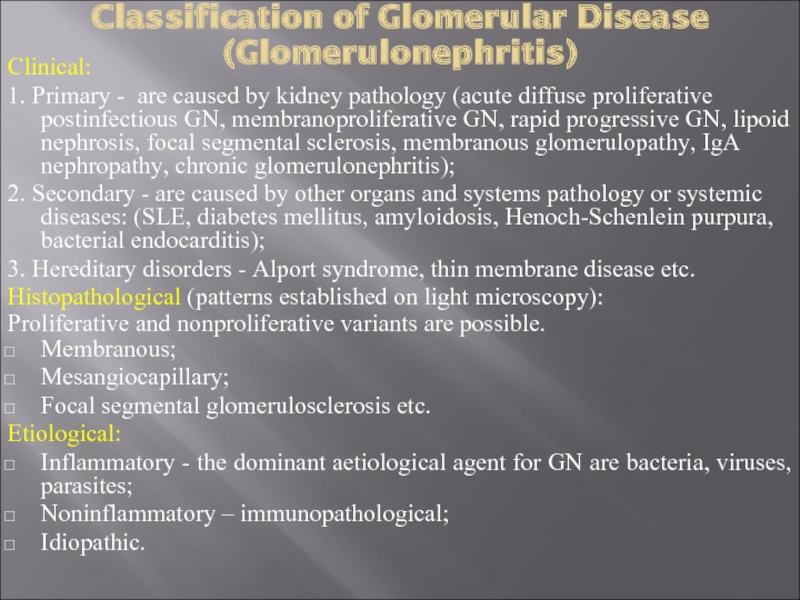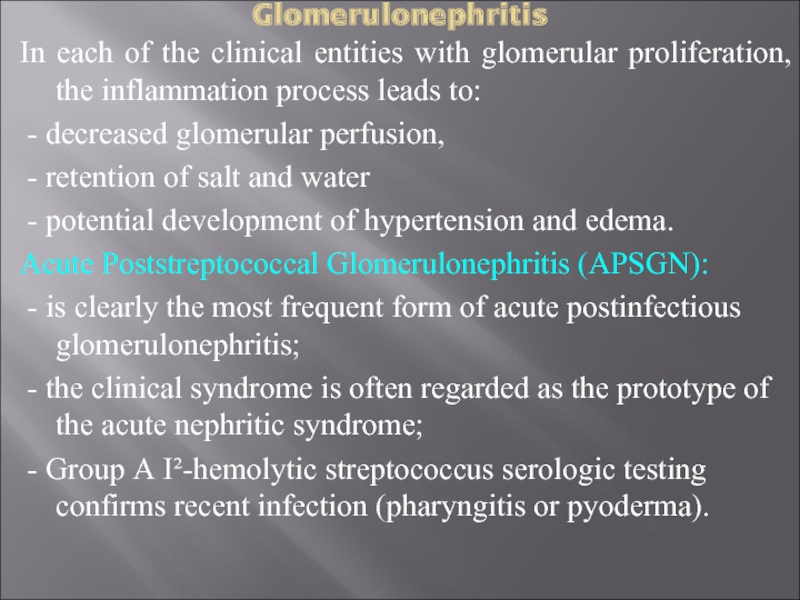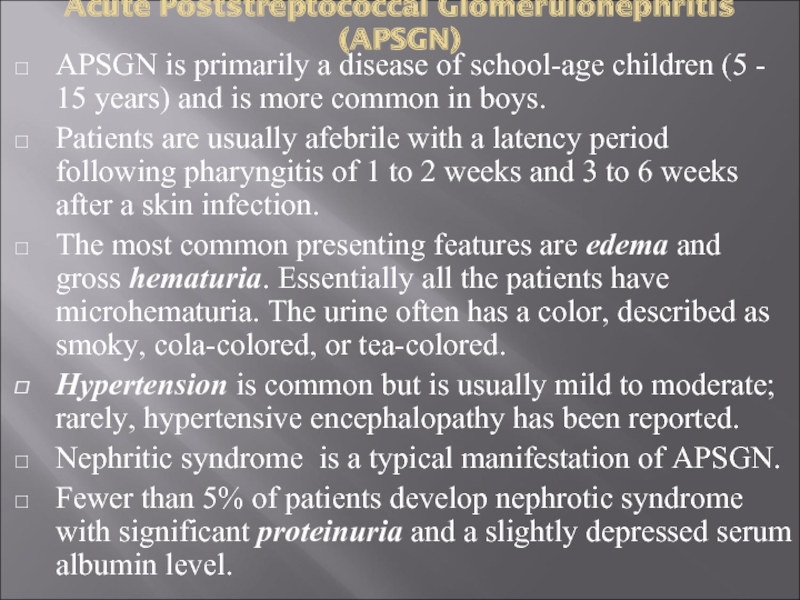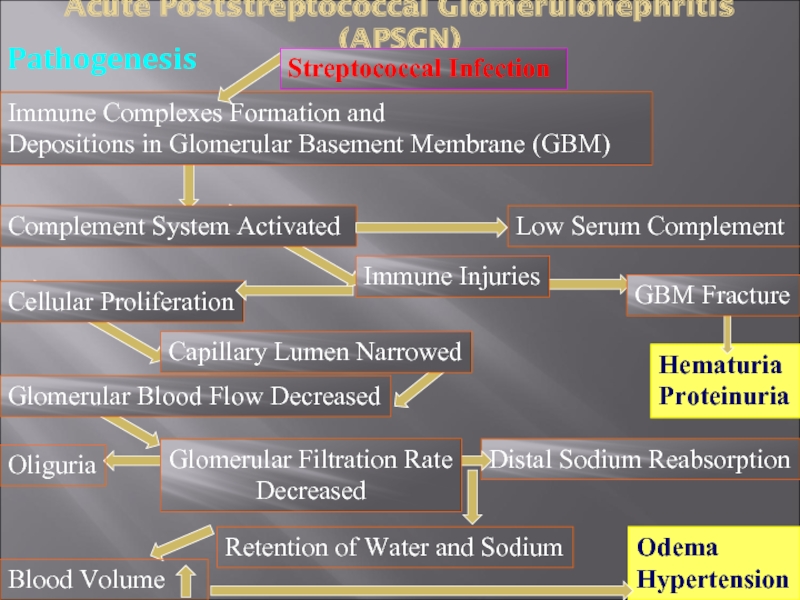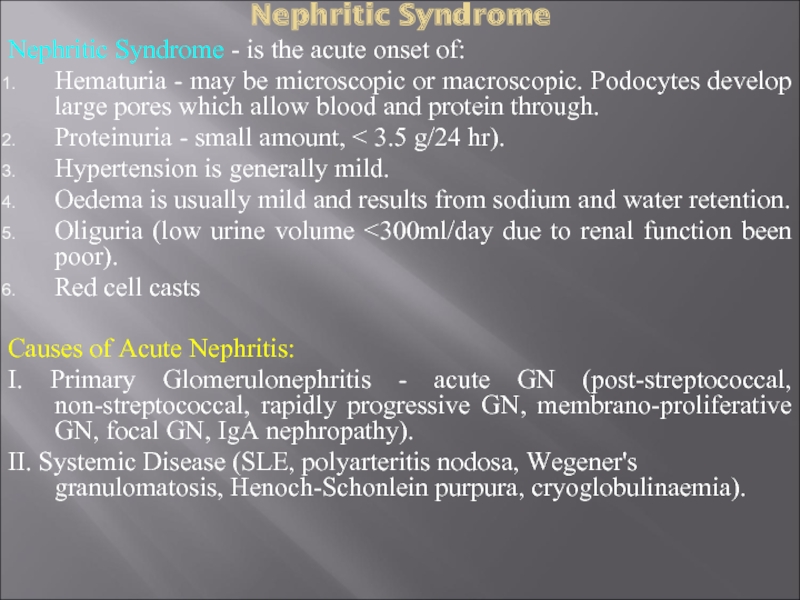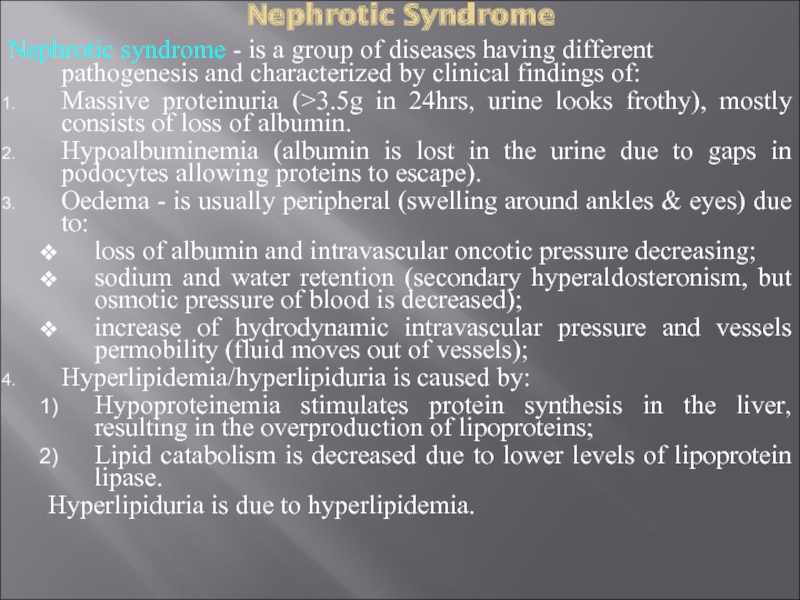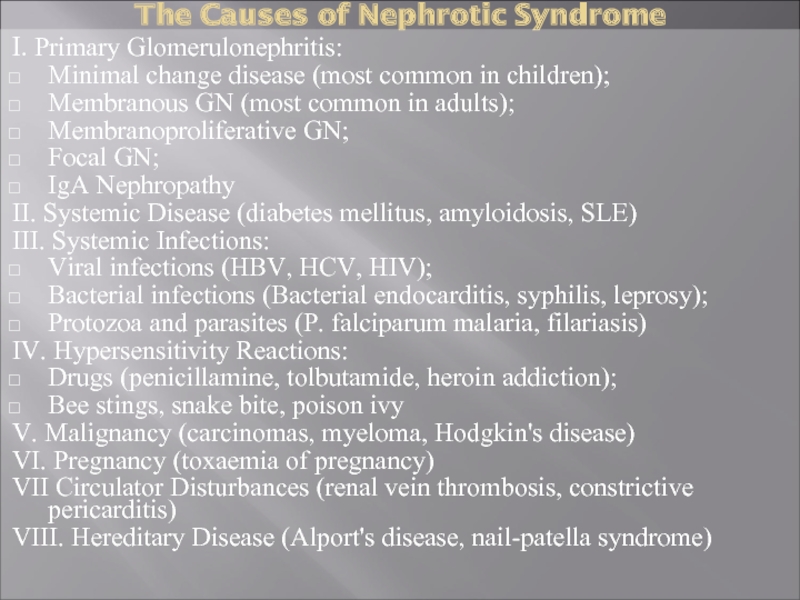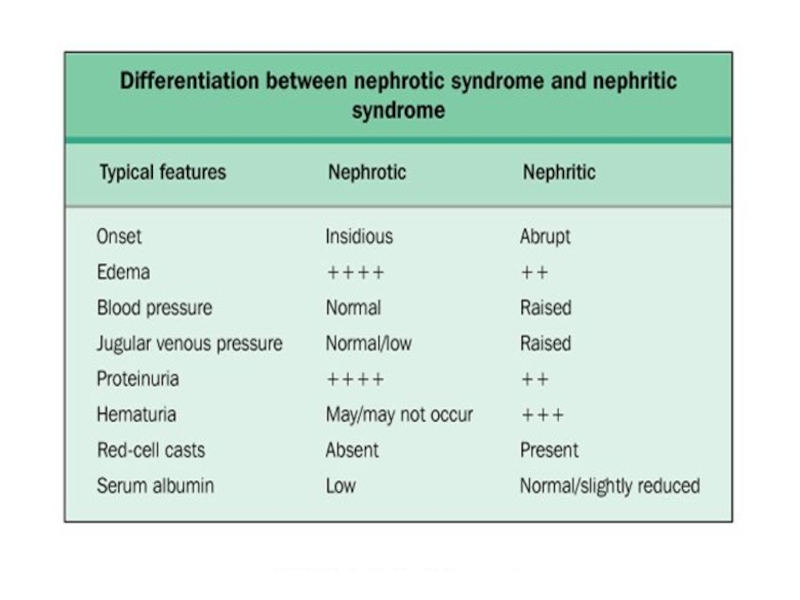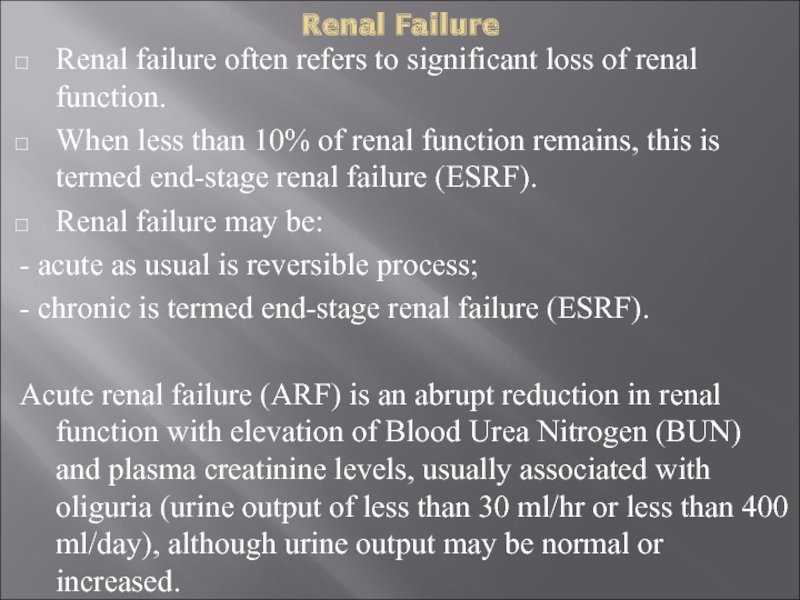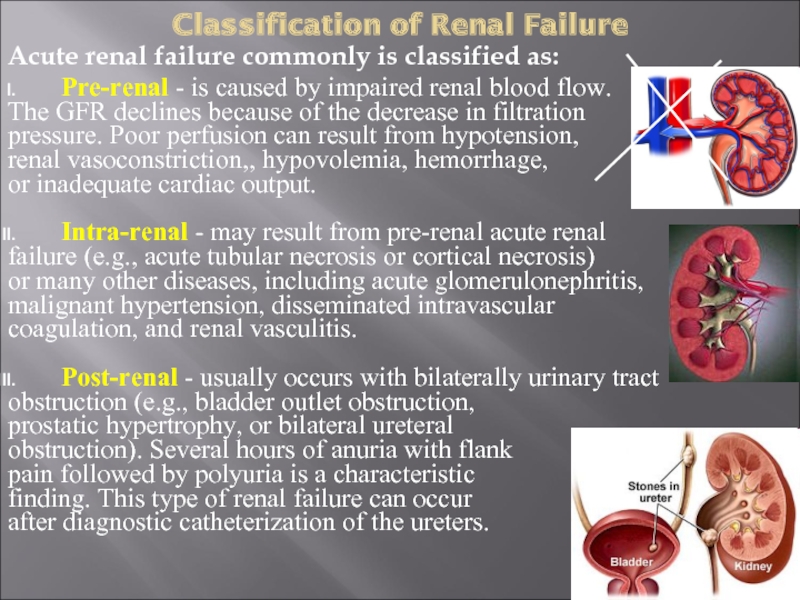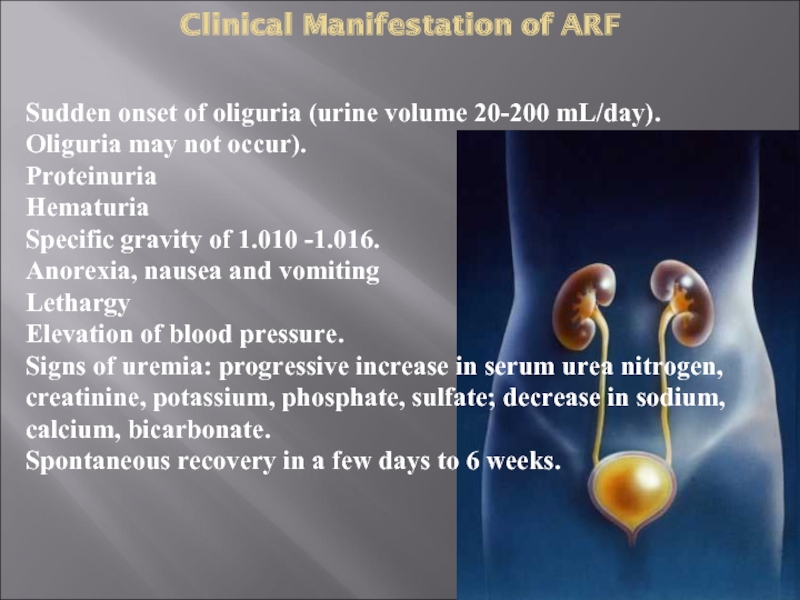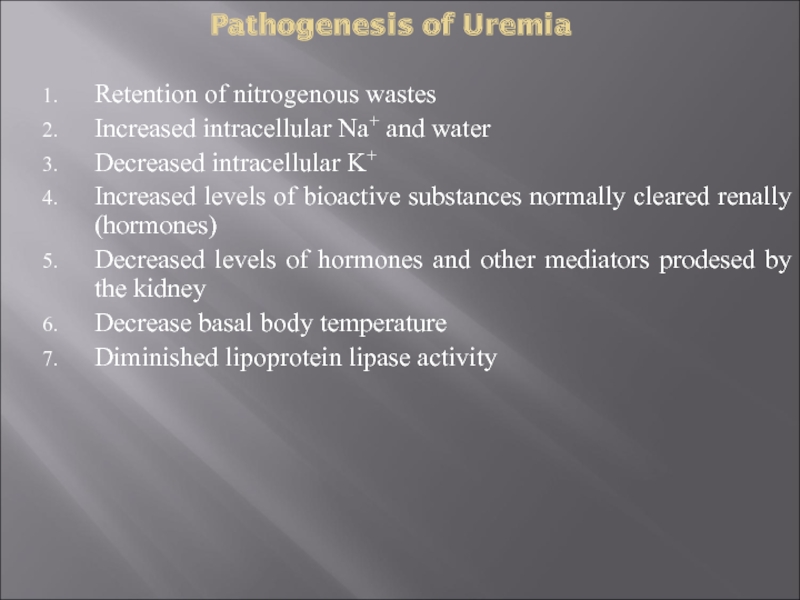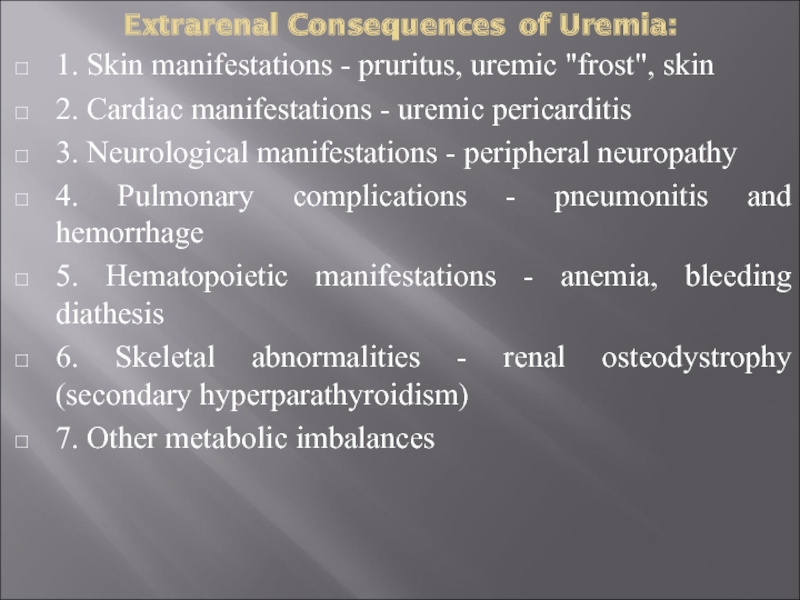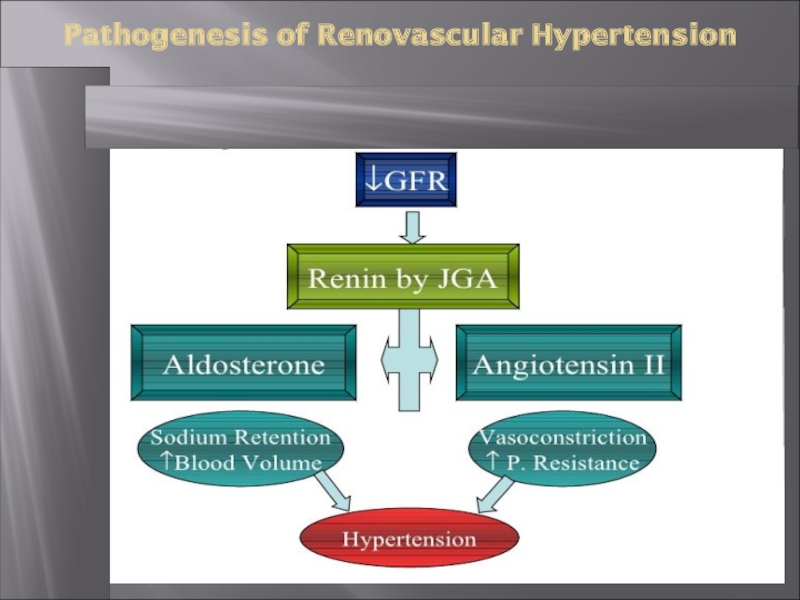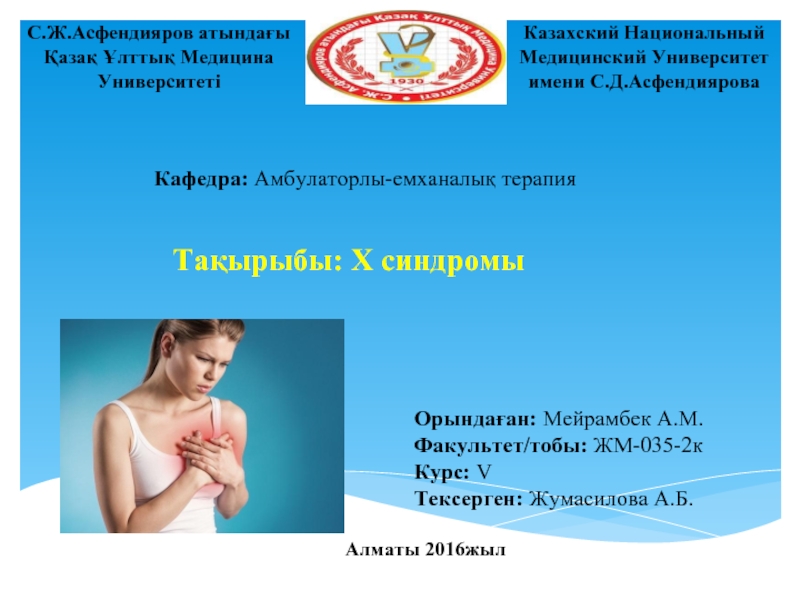- Главная
- Разное
- Дизайн
- Бизнес и предпринимательство
- Аналитика
- Образование
- Развлечения
- Красота и здоровье
- Финансы
- Государство
- Путешествия
- Спорт
- Недвижимость
- Армия
- Графика
- Культурология
- Еда и кулинария
- Лингвистика
- Английский язык
- Астрономия
- Алгебра
- Биология
- География
- Детские презентации
- Информатика
- История
- Литература
- Маркетинг
- Математика
- Медицина
- Менеджмент
- Музыка
- МХК
- Немецкий язык
- ОБЖ
- Обществознание
- Окружающий мир
- Педагогика
- Русский язык
- Технология
- Физика
- Философия
- Химия
- Шаблоны, картинки для презентаций
- Экология
- Экономика
- Юриспруденция
Kidneys pathology. (Subject 17) презентация
Содержание
- 1. Kidneys pathology. (Subject 17)
- 2. Lecture Plan
- 3. Function of Kidneys The kidneys are essentially
- 4. Function of Kidneys Homeostasis: Sodium/Volume; Water/Osmolarity; Asid/Base;
- 5. Quantitative changes of urine Normal urine
- 6. Qualitative changes of urine Hypohromuriya is
- 7. Qualitative changes of urine Normal urine
- 8. Qualitative changes of urine Relative density
- 9. Qualitative changes of urine Pathological admixtures
- 10. Nonpathological proteinuria - excessive protein excretion is
- 11. Haematuria is defined as appearance of RBC
- 12. Visible (macroscopic) haematuria (VH) Non-visible (microscopic) haematuria
- 13. Qualitative changes of urine Pathological admixtures
- 17. Classification of Glomerular Disease (Glomerulonephritis) Clinical:
- 18. Glomerulonephritis In each of the clinical
- 19. Acute Poststreptococcal Glomerulonephritis (APSGN) APSGN is primarily
- 20. Acute Poststreptococcal Glomerulonephritis (APSGN) Pathogenesis
- 21. Nephritic Syndrome Nephritic Syndrome - is the
- 22. Nephrotic Syndrome Nephrotic syndrome - is a
- 23. The Causes of Nephrotic Syndrome I. Primary
- 25. Renal Failure Renal failure often refers
- 26. Classification of Renal Failure Acute renal
- 27. Clinical Manifestation of ARF
- 28. Chronic Renal Failure Pathophysiology and Clinical manifestations
- 29. Pathogenesis of Uremia Retention of nitrogenous
- 30. Extrarenal Consequences of Uremia: 1. Skin
- 31. Pathogenesis of Renovascular Hypertension
- 32. Thank you for your attention
Слайд 3Function of Kidneys
The kidneys are essentially regulatory organs which maintain the
The kidneys take their blood supply directly from the aorta via the renal arteries; blood is returned to the inferior vena cava via the renal veins
The kidneys are critical in regulating the internal environment of the body.
Слайд 4Function of Kidneys
Homeostasis:
Sodium/Volume;
Water/Osmolarity;
Asid/Base;
Electrolytes (K+, Ca++, Mg++, HPO4)
Endocrine function:
Renin;
Erythropoietin;
1,25 – Vitamin D
Hemodynamic
Renin / Angiotensin / Aldosteron;
Sodium balance;
Pressure natriuresis
Clearance:
Products of metabolism;
Drugs and toxins;
Слайд 5Quantitative changes of urine
Normal urine volume is 750 to 2000
Polyuria - increase the daily amount
of urine are usually caused by:
- absorption of edema, transudate, exudate;
- states after feverish;
- primary aldosteronism;
- hyperparathyroidism;
- nephrosclerosis;
- diabetes and diabetes insipidus
Oliguria - a reduction of daily amount
of urine are usually caused by:
- febrility;
- heart disease;
- acute renal failure;
- nephrosclerosis.
Anuria - a lack of urine,
less than 50 ml per day.
- acute renal failure;
- severe nephritis;
- meningitis (reflex);
- poisoning;
- tetany;
blockage of the urinary tract
tumor or stone
Слайд 6Qualitative changes of urine
Hypohromuriya is physiological if it’s caused by
Pathological hypohromuriya is developed due to:
- diabetes;
- diabetes insipidus;
- nephrosclerosis.
Color of urine
Normally, urine is amber or straw-yellow color.
Changes in urine color is possible with a number of
physiological and pathological conditions.
Hyperhromuria is physiological if it’s caused by oliguria as a result of limit drinking, sweating, eating carrots in the food.
Pathological hyperhromuria
is developed due to:
- diarrhea;
- toxicoses;
- fever;
- vomiting;
- liver disease, heart disease;
- hemolytic state.
Слайд 7Qualitative changes of urine
Normal urine is transparent. While standing in
Turbidity of urine caused by crystals, cellular elements, bacteria, mucus, and fat.
The reaction of the urine is normal when pH is 5,5-7,0.
Acidic:
- diabetes (predkoma, coma);
- fevers;
- starvation;
- renal failure;
- tuberculosis of kidneys;
- leukemia;
- hypokalemic state (paradoxical aciduria)
Alkaline:
- haematuria;
- after vomiting and diarrhea;
-resorption of exudates, transudate;
- taking soda and mineral water;
- hyperhloremic acidosis;
- renal tubular acidosis;
- chronic urinary tract infections
Pathology of urine рН:
Слайд 8Qualitative changes of urine
Relative density of urine ranged from 1.010
Hypostenuria - is low relative density of urine. It indicates that concentrating function of the kidneys has lost:
-in the morning portion of healthy individuals;
-in febrile patients;
-a reduced amount of urine;
-with amyloid and lipoid nephrosis;
-diabetes mellitus, glycosuria;
-hyperparathyroidism, etc.
-diabetes insipidus;
-resorption of edema and inflammatory infiltrates;
-chronic pyelonephritis;
-chronic nephritis;
-chronic renal failure;
-nephrosclerosis;
- glomerulonephritis.
Isostenuria - an absence of specific gravity‘s daily deviations. It
means that the diluting and concentrating functions of the
kidneys have both been lost:
-the latest stage of hronic renal failure;
-severe subacute and chronic nephritis.
Hyperstenuria - is the high
relative density of urine to ,030-
1,034 and often can be caused by
extra renal disturbances:
Слайд 9Qualitative changes of urine
Pathological admixtures in urine
Proteinuria is defined as
150 mg/day.
The mechanism of proteinuria may be related to 2 aspects:
Molecular barrier injury: holes on glomerular basement membrane (GBM) become larger, plasma protein can pass through the GBM into the urine;
Charge barrier injury: loss of negative charge (glycoprotein) within GBM, plasma protein (with negative charge) can pass through the GBM into urine.
Слайд 10Nonpathological proteinuria - excessive protein excretion is apparently not the result
Postural (orthostatic)
Febrile
Exercise-induced
Pathological proteinuria results from glomerular or tubular disorders. It is characterized by persistent and severe intensity - more than 3.5 g/l.
Tubular:
Inherited - Cystinosis, Wilson disease, Lowe syndrome);
Acquired - Antibiotic-induced, Interstitial nephritis, Acute tubular necrosis, Heavy metal poisoning);
Glomerular - nephrotic syndrome, idiopathic, mesangial proliferation, focal sclerosis, glomerulonephritis, systemic diseases (lupus erythematosus), drugs, hypertension, diabetes mellitus, hemolytic uremic syndrome and other renal diseases.
Proteinuria may be divided into two categories:
Слайд 11Haematuria is defined as appearance of RBC in urine
Common Causes
IgA nephropathy (Berger’s disease);
Thin glomerular basement membrane disease;
Hereditary nephritis (Alport’s syndrome).
Common Causes of Non-Glomerular Hematuria:
Upper Tract:
Urolithiasis;
Pyelonephritis;
Renal cell cancer;
Transitional cell carcinoma;
Urinary obstruction;
Benign hematuria
Lower Tract:
Bacterial cystitis;
Benign prostatic hyperplasia;
Transitional cell carcinoma;
Strenuous exercise (“marathon runner’s hematuria”);
Spurious hematuria (e.g. menses);
Instrumentation;
Benign hematuria
Qualitative changes of urine
RENAL
URETERAL
BLADDER
URETHRAL
Слайд 12Visible (macroscopic) haematuria (VH)
Non-visible (microscopic) haematuria (NVH) - is not visible
Macroscopic hematuria can be divided into three types:
Initial Hematuria - bleeding that occurs at the start of urination. This could indicate a problem in the urethra in women or the prostate (in men).
Total Hematuria - bleeding that occurs while urinating is known as total hematuria. Men could experience total hematuria because of an enlarged prostrate. In women, vaginal bleeding during urination could be an indication of an infection in the bladder, ureter or kidneys.
Terminal Hematuria - bleeding after urination in men and women. Blood after urination in women is usually indicative of a bladder infection. Men can also experience terminal hematuria because of prostate diseases.
Haematuria is most usefully divided into:
Слайд 13Qualitative changes of urine
Pathological admixtures in urine
Leukocyturia is the presence
Usually, the WBC's in urine are granulocytes.
The common diseases that may result to the presence of leukocytes in urine:
Urinary tract infection;
Cystitis – is the inflammation of the bladder (the infection has made its way from the urethra to the bladder, spreading the infection and damaging parts of the kidneys).
Pyelonephritis –is case, the infection has affected not only the urethra and the bladder, but also the kidneys.
Слайд 17Classification of Glomerular Disease (Glomerulonephritis)
Clinical:
1. Primary - are caused by
2. Secondary - are caused by other organs and systems pathology or systemic diseases: (SLE, diabetes mellitus, amyloidosis, Henoch-Schenlein purpura, bacterial endocarditis);
3. Hereditary disorders - Alport syndrome, thin membrane disease etc.
Histopathological (patterns established on light microscopy):
Proliferative and nonproliferative variants are possible.
Membranous;
Mesangiocapillary;
Focal segmental glomerulosclerosis etc.
Etiological:
Inflammatory - the dominant aetiological agent for GN are bacteria, viruses, parasites;
Noninflammatory – immunopathological;
Idiopathic.
Слайд 18Glomerulonephritis
In each of the clinical entities with glomerular proliferation, the
- decreased glomerular perfusion,
- retention of salt and water
- potential development of hypertension and edema.
Acute Poststreptococcal Glomerulonephritis (APSGN):
- is clearly the most frequent form of acute postinfectious glomerulonephritis;
- the clinical syndrome is often regarded as the prototype of the acute nephritic syndrome;
- Group A I²-hemolytic streptococcus serologic testing confirms recent infection (pharyngitis or pyoderma).
Слайд 19Acute Poststreptococcal Glomerulonephritis (APSGN)
APSGN is primarily a disease of school-age children
Patients are usually afebrile with a latency period following pharyngitis of 1 to 2 weeks and 3 to 6 weeks after a skin infection.
The most common presenting features are edema and gross hematuria. Essentially all the patients have microhematuria. The urine often has a color, described as smoky, cola-colored, or tea-colored.
Hypertension is common but is usually mild to moderate; rarely, hypertensive encephalopathy has been reported.
Nephritic syndrome is a typical manifestation of APSGN.
Fewer than 5% of patients develop nephrotic syndrome with significant proteinuria and a slightly depressed serum albumin level.
Слайд 21Nephritic Syndrome
Nephritic Syndrome - is the acute onset of:
Hematuria - may
Proteinuria - small amount, < 3.5 g/24 hr).
Hypertension is generally mild.
Oedema is usually mild and results from sodium and water retention.
Oliguria (low urine volume <300ml/day due to renal function been poor).
Red cell casts
Causes of Acute Nephritis:
I. Primary Glomerulonephritis - acute GN (post-streptococcal, non-streptococcal, rapidly progressive GN, membrano-proliferative GN, focal GN, IgA nephropathy).
II. Systemic Disease (SLE, polyarteritis nodosa, Wegener's granulomatosis, Henoch-Schonlein purpura, cryoglobulinaemia).
Слайд 22Nephrotic Syndrome
Nephrotic syndrome - is a group of diseases having different
Massive proteinuria (>3.5g in 24hrs, urine looks frothy), mostly consists of loss of albumin.
Hypoalbuminemia (albumin is lost in the urine due to gaps in podocytes allowing proteins to escape).
Oedema - is usually peripheral (swelling around ankles & eyes) due to:
loss of albumin and intravascular oncotic pressure decreasing;
sodium and water retention (secondary hyperaldosteronism, but osmotic pressure of blood is decreased);
increase of hydrodynamic intravascular pressure and vessels permobility (fluid moves out of vessels);
Hyperlipidemia/hyperlipiduria is caused by:
Hypoproteinemia stimulates protein synthesis in the liver, resulting in the overproduction of lipoproteins;
Lipid catabolism is decreased due to lower levels of lipoprotein lipase.
Hyperlipiduria is due to hyperlipidemia.
Слайд 23The Causes of Nephrotic Syndrome
I. Primary Glomerulonephritis:
Minimal change disease (most common
Membranous GN (most common in adults);
Membranoproliferative GN;
Focal GN;
IgA Nephropathy
II. Systemic Disease (diabetes mellitus, amyloidosis, SLE)
III. Systemic Infections:
Viral infections (HBV, HCV, HIV);
Bacterial infections (Bacterial endocarditis, syphilis, leprosy);
Protozoa and parasites (P. falciparum malaria, filariasis)
IV. Hypersensitivity Reactions:
Drugs (penicillamine, tolbutamide, heroin addiction);
Bee stings, snake bite, poison ivy
V. Malignancy (carcinomas, myeloma, Hodgkin's disease)
VI. Pregnancy (toxaemia of pregnancy)
VII Circulator Disturbances (renal vein thrombosis, constrictive pericarditis)
VIII. Hereditary Disease (Alport's disease, nail-patella syndrome)
Слайд 25Renal Failure
Renal failure often refers to significant loss of renal
When less than 10% of renal function remains, this is termed end-stage renal failure (ESRF).
Renal failure may be:
- acute as usual is reversible process;
- chronic is termed end-stage renal failure (ESRF).
Acute renal failure (ARF) is an abrupt reduction in renal function with elevation of Blood Urea Nitrogen (BUN) and plasma creatinine levels, usually associated with oliguria (urine output of less than 30 ml/hr or less than 400 ml/day), although urine output may be normal or increased.
Слайд 26Classification of Renal Failure
Acute renal failure commonly is classified as:
Pre-renal
The GFR declines because of the decrease in filtration
pressure. Poor perfusion can result from hypotension,
renal vasoconstriction,, hypovolemia, hemorrhage,
or inadequate cardiac output.
Intra-renal - may result from pre-renal acute renal
failure (e.g., acute tubular necrosis or cortical necrosis)
or many other diseases, including acute glomerulonephritis,
malignant hypertension, disseminated intravascular
coagulation, and renal vasculitis.
Post-renal - usually occurs with bilaterally urinary tract
obstruction (e.g., bladder outlet obstruction,
prostatic hypertrophy, or bilateral ureteral
obstruction). Several hours of anuria with flank
pain followed by polyuria is a characteristic
finding. This type of renal failure can occur
after diagnostic catheterization of the ureters.
Слайд 28Chronic Renal Failure
Pathophysiology and Clinical manifestations of Uremic syndrome
Uremia is a
Azotemia means increased serum urea levels and frequently increased creatinine levels as well. Renal failure causes azotemia.
Both azotemia and uremia indicate an accumulation of nitrogenous waste products in the blood.
Слайд 29Pathogenesis of Uremia
Retention of nitrogenous wastes
Increased intracellular Na+ and water
Decreased
Increased levels of bioactive substances normally cleared renally (hormones)
Decreased levels of hormones and other mediators prodesed by the kidney
Decrease basal body temperature
Diminished lipoprotein lipase activity
Слайд 30Extrarenal Consequences of Uremia:
1. Skin manifestations - pruritus, uremic "frost",
2. Cardiac manifestations - uremic pericarditis
3. Neurological manifestations - peripheral neuropathy
4. Pulmonary complications - pneumonitis and hemorrhage
5. Hematopoietic manifestations - anemia, bleeding diathesis
6. Skeletal abnormalities - renal osteodystrophy (secondary hyperparathyroidism)
7. Other metabolic imbalances


